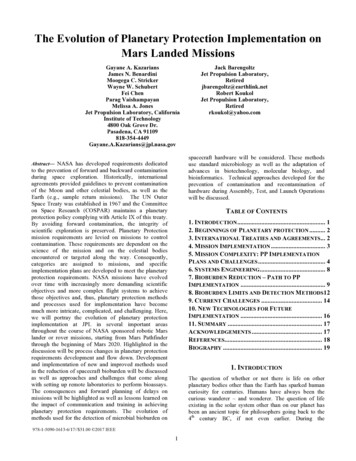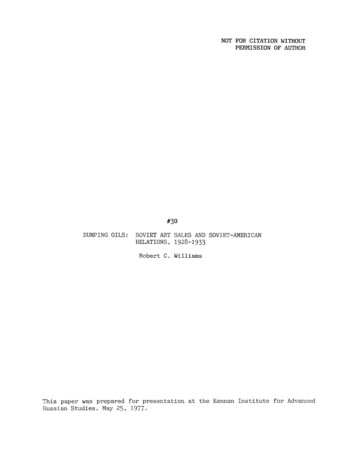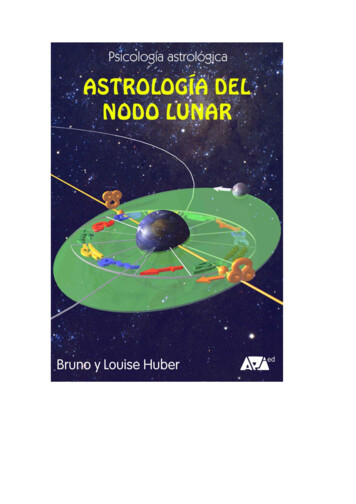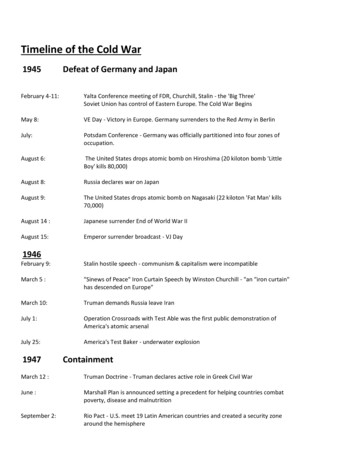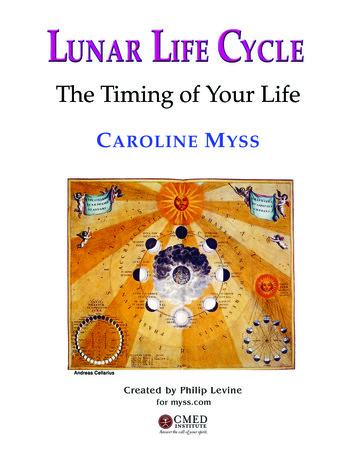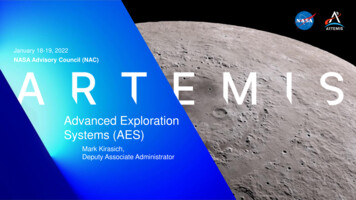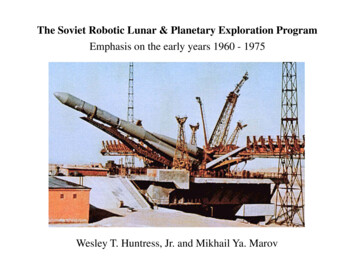
Transcription
The Soviet Robotic Lunar & Planetary Exploration ProgramEmphasispon the earlyy yyears 1960 - 1975Wesley T. Huntress, Jr. and Mikhail Ya. Marov
The Soviet Robotic Lunar & Planetary Exploration ProgramBorn as part of the Cold War and nearly died with itProvided a sinister and mysterious stimulus to American effortsA tale of adventure, excitement, suspense and tragedyA tale of courage and patience to overcome obstacles and failureA tale of fantastic accomplishment, and debilitating lossM t eventsMostt virtuallyi t ll unknownkoutsidet id theth closedl d circlei l off SovietS i t secrecy
Mstislav KeldshSergei Korolev
1960 - Early Soviet and American Exploration RocketsVanguardLunaJupiter-CMolniyaAtlas-Agena
1958 - 1959 The Age of Robotic Lunar Exploration Opens1958958 - 3 faileda ed impactorpac o launchesau c es1959 - 1 failed impactor launches- 3 successful (Lunas 1, 2, 3)1960 - 2 failed circumlunar launchesLuna 1 January 2, 19591st s/c to leave Earthmissed lunar impact1st lunar flyby Jan 4, 1959Luna 2 1stL1 t lunarliimpactortSept 14, 1959Luna 3 circumlunar flyby1st farside pictureOct 7, 1959
1960 - 1961 The Age of Robotic Planetary Exploration OpensThe first launches to Mars and VenusOctober 10 & 14 19602 Mars flyby launch failuresMaiden flight of the MolniyaFebruary 19612 Venus impactor launches1 success on Feb 12, 1961,but Venera 1 fails 5 days later
1962 The New 2MV Planetary SpacecraftModularodula design fofor both Venus & Marsa s and fofor both flyby and pprobeobe missionsMars 1 Flyby SpacecraftFive of six victimized byy the launch vehicle- 2 Venus probes, 1 Venus flyby- 1 Mars probe, 1 Mars flybyMars 1 flyby vehicle successfully launched- ACS problems, fails after 5 months- while the US Mariner 2 succeeds at VenusMars 1 launched Nov 21, 1962Lost inflight March 21, 1963
1963 - 1965 Three More Years of FrustrationA new 1500 kg spacecraft for lunar soft landingtransport module plus landing capsuleEleven failed missions in 1963 – 1965!Six due to launch vehicle failuresLuna 4 - navigation failed, missed the MoonLuna 5 – guidance failed, crashedLuna 6 – mid-course failed, missed the MoonLuna 7 – attitude control & retro failed, crashedLuna 8 – air bag puncture & retro failed, crashedAir-bagAirbag landing scheme
1963 - 1965 Three More Years of FrustrationBack to Mars and Venus with a new planetary spacecraft - the 3MVZond 3 Mars s/c & lunar farside pictureNov 11, 1963 – Test flight launch to Mars distance failsFeb 19, 1964 – Test flight launch to Venus distance failsMar 27, 1964 – Venus pprobe launch failsApril 2, 1964 – Zond 1 Venus probe, lost May 25, 1964 due to slow leakNov 30, 1964 – Zond 2 Mars flyby, lost May 5, 1965 after multiple problemsJuly 18, 1965 – Zond 3 Mars test succeeds at the Moon, survives for 8 mo., 150M kmNov 1212, 1965 – Venera 2 Venus flybyflyby, thermal problemsproblems, failed to return flyby dataNov 16, 1965 – Venera 3 Venus probe, thermal problems, lost 17 days before arrivalNov 23, 1965 – Venera flyby launch fails
1966 - 1969 Success at the Moon and Venus, but Mars eludesLunau a 9 - Thehe fifirstst lunarluna soft lander,lande , Febeb 3, 1966966LLuna13 – DecD 2424, 1966
1966 - 1969 Success at the Moon and Venus, but Mars eludesFirst Soviet Lunar Orbiters - 1966Rushed together from Luna 9/13 vehicleReplaced lander module with orbiter module4 off 7 succeedd Marchh 1966 – AprilA il 1968Luna 10 1st lunar orbiter – April 3, 1966Luna 10Luna 11, 12, 14Lunar gravity mapping – mascons!Radiation and magnetic field mappingCCosmonautllandingdi sitei imageryiTechnology tests for piloted programLuna 12 Image
1966 - 1969 Success at the Moon and Venus, but Mars eludesVenera 4 - Inside the Venusian Atmosphere Oct 18, 1967Last T - 262 CLast P - 18 barAltitude - 24 km CO2N2O2H2O 90%90%Derived @ surface: 2.5%442 C0.4-1.6%90 bar0.05-0.70 %Venera 5 and 6 follow up in May 1969 – both cease at 27 bar, 18 km
1966 - 1969 Success at the Moon and Venus, but Mars eludesA bold new program for Mars goes bustNew & demanding goal - soft landingComprehensive science objectives defined1969 campaign to get atm & ephemeris dataUpstage Mariner 69 flybys and 71 orbitersNew heavy design for Proton launch3 new development3yrd lt challengeh llDiverted by rush to succeed at Venus in ‘67Lunar spacecraft based design failsg13 month for redesign 3574 kg Orbiter with 280 kg ProbeProbe to be deployed from orbitProbe deleted late: mass & test problemsReplaced with orbital moduleMars 69 under test at LavochkinFi l launchFinallh mass 4850 kgkBoth Protons explodedThird stage on March 27, 1969Booster on April 2, 1969Missions virtually unknown in West
1969 - 1976 Robotic Achievements in the Shadow of ApolloNew 5800kg Robotic Lunar Rovers and Sample Return SpacecraftRoverSample ReturnLuna 16Luna 17Used new Proton-K launcher
1969 - 1976 Robotic Achievements in the Shadow of ApolloRobotic Lunar Rovers and Sample ReturnRover Launch History1969, Feb 19 Launch failure1970, Nov 10 Luna 17/Lunokhod 11973, Jan 8 Luna 21/Lunokhod 2Sample Return Launch History1969, Jun 14 Launch failure1969, Jul 13 Luna 15, crashed1969, Sep 23 Launch failure1969, Oct 22 Launch failure1969, Feb 6 Launch failure1970 Sep 12 Luna 161970,16, success1971, Sep 2 Luna 18, failed at landing1972, Feb 14 Luna 20, success1974 Nov 2 Luna 23, damaged on landing1975, Oct 16 Launch failure1976, Aug 9 Luna 24, successFirst Lunar SampleReturn – Luna 16First Robotic Lunar Rover - Lunokhod 1
1969 - 1976 Robotic Achievements in the Shadow of ApolloLuna 19 (1971) & 22 (1974) OrbitersObtain data for human landing site selectionSurfaceSfiimagingi at highhi h resolutionl i – 100m100 x 400m400Altimetry measurements of lunar topographyRemote surface composition and dielectric propertiesAccurate mappingpp g of lunar ggravityy fieldRadiation, plasma, micrometeorites in lunar orbit
1970 - 1972 Landing on Venus and MarsFirst landing on Venus Dec 15, 1970, Venera 7Venera 7 s/c1970Venera 7 launch Augg 17, 19702nd launch fails Aug 22, 1970Venera 7 lands Dec 15, 19701972Venera 8 launch Mar 27, 19722nd launch fails Mar 31, 1972Venera 7 capsuleVenera 8 lands Jul 22, 1972
1970 - 1972 Landing on Venus and MarsThree spacecraft for Mars landings in 1971New 5-ton spacecraft design for Proton launchUS refuses to provide Mars ephemerisFast ‘pathfinder’ orbiter launch failsMMars2 3 orbiter/landers2,3bit /l d use autot opticalti l nav
First landing on Mars Dec 2, 1971, Mars 3Mars 2 crashedMars 3 lander fails 2 min after landingDescent SequenceqLander DeployedEntry System Deployment
1973 - 1974 The Doomed Mars FleetFour spacecraft launched in 1973Recover 1971 failures, beat Viking to the surfaceC ld nott combineCouldbi orbitersbit andd landersl d ini 1973Launched two orbiters and two flyby/landersVirtual copies of the Mars 71 spacecraftExcept for a crucial substitution of a transistorAll spacecraft plagued with onboard failuresMars 4,5Mars 6,7
1973 - 1974 The Doomed Mars FleetLittleittle resultesult forfo a massive investmentMars 4 orbiter flew past planetMars 5 orbiter short livedMars 6 gets T, P, wind data on descent, lost on landingMars 7 lander flew past planetMars 4 flyby imageMars 5 orbiter color imagesMars 5 orbiter image
The later years 1975 - 1996Major successes at Venus and Halley 1975 - 19861975-1983: successful sophisticated landers/orbiters at Venus, Veneras 9-161984 1986 comprehensive1984-1986:h i iinternationaltti l missionsi iVegasV1-21 2 att VenusV& HalleyH llVenera 14Vega 2Failure again at Mars 1988 - 19961988: heavy, complex, international Phobos 1-2 missions fail at Mars & Phobos:obos 1 lostost een route,oute, Phobosobos 2 gets someso e data ono Marsa s & Phobosobos fromoPhobosMars orbit but fails at Phobos approach1996: massive, international Mars 96 mission lost at launch
Soviet exploration of the Solar System ends in 1996A tragic loss of vision,vision enterprise and expertise- courage and enthusiasm to try the previously impossible- superb expertise in engineering design and development- innovation in using technology available to accomplish the task- masters of materials development and engineering- masters of propulsion system engineering- excellence in celestial mechanics, navigation and guidance- excellence in automation and software, that later unraveled- produced a stable of very powerful and readily available rockets- poor reliability of launch vehicles until mid-1970s- handicapped by poor electronics technology- poor systemt engineeringii managementt- insufficient ground systems testing- complex, entangled, heavy-handed national system of control & supply
Russian exploration of the Solar System after 1996“Rumors on my death are too exaggerated” Mark Twain Disintegration of the former Soviet Union followedbysocial-economicali li l turmoiltil dramaticallydti ll impactedit don the Russian space program, specifically the Solarexplorationsystem Space budget was shrank down many folds, the lion share going for MIRorbital station operations support, MIR-Shuttles docking, and then ISS Space facilities were partially destroyed, cooperative links broken, manyskilled personnel in space science and technology lost Mars 96 failure significantly worsened the situation, the planned missionsand blue print for the planetary explorations have been abandoned
Russian exploration of the Solar System after 1996 (cont) The concept off basici spacecraftf off newgeneration for Solar system study wasdeveloped (starting by a small enthusiasticteam of scientists and engineers) during 1996– 2000 It underlined PHOBOS-SOILPHOBOS SOIL mission withgood scientific objectives, modern technologyand robust engineering Because of limited budget the mission wasthree times postponed and finally failed in2011 launch not leaving LEO Basically, the failure was caused by thefactors rooted in the destroying 1990s whichsequelsl havehnott beenbyett overcome ththoughhlessons were learned
RUSSIAN SPACE PROGRAM on SCIENCE( off 2011)(assource: http://www.esa.int
Lessons Learned: A Perspectivep“With the recent failure of the Phobos-Grunt probe the Russian planetaryexploration program is once again in the news and its leaders are on the hotseat in Russia. Perhaps it would be wise before voicing criticism of thisfailure to read this history. It will demonstrate that planetary scientists andengineers in the Soviet Union/Russia have been working with minimalresources, poor politicalli i l support, andd lesslthanh optimali l technologiesh l i forfmany years. Despite that reality, they have enhanced understanding of thesolar system in fundamental ways. Phobos-Grunt must be viewed as part of along train of missions over the years.years I hope it is not the last such missionundertaken.”DavidDid M Harland:H l d NoteN t on an IImportantt tBBook:kSoviet Robots in the Solar System: Mission Technologies and Discoveries
Back to Mars and Venus with a new planetary spacecraft - the 3MV Zond 3 Mars s/c & lunar farside picture Nov 11, 1963 – Test flight launch to Mars distance fails Feb 19, 1964 – Test flight launch to Venus distance fails Mar 27, 1964 – Venus probe launch fails April 2, 1964 – Zond 1
